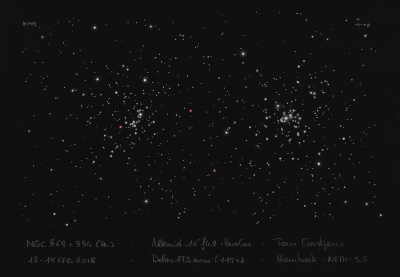h Persei Cluster
h Persei Cluster

Hipparchus catalogued the Double Cluster about 130 BC and Ptolemy copied it into his Almagest: "At the tip of the right hand [of Perseus] and nebulous [or misty]." Giovanni Battista Hodierna (1654) resolved the double cluster into stars. William Herschel found NGC 869 = H VI-33 on 1 Nov 1788 (sweep 877) and recorded "A very beautiful brilliant cluster of large stars, very rich. The place taken is the most compressed part of it, which is not in the middle; the middle of it contains a vacancy".
200/250mm - 8" this is the western component of the "double cluster". Very bright, large, about 30' diameter. Very rich with about 100 stars resolved, includes several bright mag 6.5-7.0 stars in the center. Forms a pair with NGC 884 at edge of 100x field.
400/500mm - 17.5" (10/25/97): this is the brighter and richer western member of the famous "double cluster". Includes a mag 6.6 star near the center and a mag 6.7 star 2.5' NNE. Close following the mag 6.6 star is a neat parabolic group of five stars opening towards the star. On the west side of this star is a rich group of ~20 stars mostly arranged in an incomplete ring. A faint curving string of stars from the mag 6.7 star leads to the parabolic quintet. The 20' field at 220x has too many stars to count, but probably has ~200 stars.
Naked-eye - (11/13/07): I noticed that the Double Cluster was clearly resolved into two "clumps" naked-eye.
Notes by Steve Gottlieb